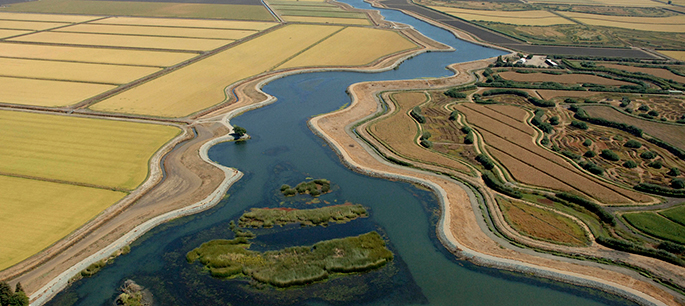One key source of conflict over the Sacramento–San Joaquin Delta is the competition over who gets to use the water. During droughts, this competition becomes acute, especially when it comes to decisions about how much water flows out to sea versus how much gets exported to cities and farms in the San Joaquin Valley, Southern California, and the Bay Area. New data from the 2014 water year illustrate the tough trade-offs California faces.
Those seeking more exports sometimes perceive the water flowing out of the Delta as “wasted to the sea.” But it is important to remember that these outflows, which are counted as water for the environment, serve two distinct purposes:
1) By pushing back seawater, outflows keep Delta water fresh enough for urban and farm uses.
2) Outflows also support habitat for endangered fish species.
Although the flows in the first category often help fish and wildlife as well, they would be needed to maintain water quality for people even if there were no fish or wildlife to worry about.
We estimate that 11.5 million acre-feet (maf) of surface flows were available within the Delta’s watershed in 2014—it was one of the drier years on record. This total included 9.5 maf from winter and spring rains plus 2 maf that had been stored in reservoirs from previous years. These low flows translated to greatly reduced use of surface water. Cities and farms that divert water upstream of the Delta, along with Delta farmers, used 5.4 maf—well below average. Just 1.9 maf of Delta water was exported, the lowest volume in decades. Water users made up for much of this shortfall by pumping extra groundwater.
 Roughly 4.2 maf flowed to the sea last year—a near-record low, but still large relative to Delta exports. The State Water Resources Control Board estimates that the most of this outflow—3 maf, or 71%—was needed to keep Delta water fresh enough for human uses (see figure). In addition, 450,000 acre-feet of water (11%) generated by three storms could have been exported, but Delta export pumps lacked the physical capacity to capture the water.
Roughly 4.2 maf flowed to the sea last year—a near-record low, but still large relative to Delta exports. The State Water Resources Control Board estimates that the most of this outflow—3 maf, or 71%—was needed to keep Delta water fresh enough for human uses (see figure). In addition, 450,000 acre-feet of water (11%) generated by three storms could have been exported, but Delta export pumps lacked the physical capacity to capture the water.
Meanwhile, the additional 750,000 acre-feet of water that was required for fish habitat—which causes the most heated debate—was just 18 percent of total outflows (and 7% of all surface water in the watershed). Under current regulatory rules, that amount would have been higher, but the water board lowered the requirement by 400,000 acre-feet to ease hardship among people dependent on Delta exports.
Given tight water supplies, there’s little doubt that this additional water flowing from the Delta could have been used for other purposes. But some of the fish species that depend on the Delta are struggling mightily during this drought. Reallocating more water to other uses almost certainly would have caused further environmental harm, and increased the chances of stricter future regulations to protect endangered fish.
The relatively large amount of water flowing out of the Delta to manage its salinity sheds light on new approaches being taken as we enter a fourth dry year. Governor Brown’s latest executive order calls for the erection of “salinity barriers” in the western Delta. These barriers will make it possible to keep the interior Delta water fresh enough to export to farms and cities, with less flowing to the sea. The water savings could also benefit some salmon runs, because more cold water could be saved upstream for release later in the year.
But this approach will also involve new trade-offs, because reductions in Delta outflows are likely to harm delta smelt as well as salmon migrating through the Delta. This is yet another example of the tough decisions water managers are having to make during these exceptionally dry times.



